One of the glories of science fiction and fantasy is the way that writers can mash up different genres and sub-genres to provide new perspectives on old tropes. This has been happening for at least as far back as Shakespeare: A Midsummer Night’s Dream mixes together Greek mythology (Theseus and Hippolyta), stories of English Faerie folk (Oberon and Titania), romantic comedy (the mismatched lovers), and lowbrow slapstick (the “rude mechanicals”) to obtain a play which throws a fresh light on all its elements. The play is also ridiculously funny, which is why it’s still a favorite with modern audiences.
I like funny. I love funny. Most of the stories I’ve written contain plenty of laughter, even when they deal with serious subjects. And mashing together different sub-genres is a perfect opportunity for jokes.
Let’s face it: plenty of SF tropes are balloons just waiting to be popped. If a book lives entirely in a single genre—swords & sorcery, say, or urban fantasy—then its preconceptions reinforce each other and hold off the clichés from collapsing. But as soon as you gather all the things that a genre takes for granted and you slam them into a different world-view, pretensions get skewered and the same-old-same-old does a pratfall. The result is often laughter.
Putting different genres together also lets you come up with brand new story-lines that readers haven’t seen before. I tried to do that in my newly published book, All Those Explosions Were Someone Else’s Fault, which mashes superheroes together with monsters like vampires and werewolves. In the list below, I’d like to offer a number of other sub-genre mash-ups that I remember fondly for making me laugh.
Radiance by Catherynne M. Valente
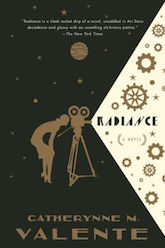 In this wonderful book, the solar system isn’t made up of inhospitable hunks of rock, but of all the exotic worlds that pulp fiction once imagined. The diverse planets and moons are bound together by the milk of whales from Venus, and black & white movies made on the moon. The style of the book mixes film documentary, alternate history, swashbuckling, hardboiled noir, Hollywood glamour, magic realism, and just plain weirdness. It’s like nothing else in the genre, and even the language is gorgeous—the opening monologue alone is worth the price of admission. (By the way, I “read” Radiance by listening to the audiobook, which I highly recommend. The reader, Heath Miller, worked closely with Valente to do a bang-up job of narrating.)
In this wonderful book, the solar system isn’t made up of inhospitable hunks of rock, but of all the exotic worlds that pulp fiction once imagined. The diverse planets and moons are bound together by the milk of whales from Venus, and black & white movies made on the moon. The style of the book mixes film documentary, alternate history, swashbuckling, hardboiled noir, Hollywood glamour, magic realism, and just plain weirdness. It’s like nothing else in the genre, and even the language is gorgeous—the opening monologue alone is worth the price of admission. (By the way, I “read” Radiance by listening to the audiobook, which I highly recommend. The reader, Heath Miller, worked closely with Valente to do a bang-up job of narrating.)
The Eyre Affair by Jasper Fforde
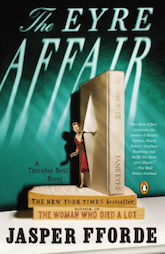 Thursday Next is a veteran of the Crimean War; she owns a pet dodo and works as a literary detective. This means that she investigates crimes against books … because in her world, thanks to the Prose Portal, it’s possible to enter works of fiction and affect their stories. In the course of the book, Thursday chases a supervillain into Jane Eyre and … I’d better not spoil it. But The Eyre Affair and its sequels are jaw-dropping combinations of mystery stories, thrillers, and fantasy that keep going in directions you’d never expect.
Thursday Next is a veteran of the Crimean War; she owns a pet dodo and works as a literary detective. This means that she investigates crimes against books … because in her world, thanks to the Prose Portal, it’s possible to enter works of fiction and affect their stories. In the course of the book, Thursday chases a supervillain into Jane Eyre and … I’d better not spoil it. But The Eyre Affair and its sequels are jaw-dropping combinations of mystery stories, thrillers, and fantasy that keep going in directions you’d never expect.
Smoke and Shadows by Tanya Huff
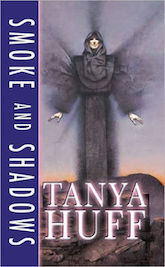 This is the first of three books, all of which are set behind the scenes of a TV show featuring a vampire detective. Counter to what you might expect, the star of the show isn’t a real vampire; however, one of the people backstage is a real wizard, another is the protégé of an elder vampire, and other supernatural connections slowly make themselves known. The result combines urban fantasy and mystery, with a lot of sly jokes about the television industry and even a charming love story that develops gradually over the course of the trilogy.
This is the first of three books, all of which are set behind the scenes of a TV show featuring a vampire detective. Counter to what you might expect, the star of the show isn’t a real vampire; however, one of the people backstage is a real wizard, another is the protégé of an elder vampire, and other supernatural connections slowly make themselves known. The result combines urban fantasy and mystery, with a lot of sly jokes about the television industry and even a charming love story that develops gradually over the course of the trilogy.
Jhereg by Steven Brust
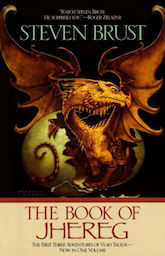 The Vlad Taltos series has taken many twists and turns in its fifteen-book history, but it started with Jhereg. In that book, Vlad Taltos is a professional assassin in a swords & sorcery world … except, wait, there’s actually a (sort of) scientific explanation for how things got the way they are. And Taltos is more of a hard-bitten private eye than a run-of-the-mill hitman. A hard-bitten private eye who uses witchcraft. And whose cynical point of view keeps deflating all the people and tropes he runs into. It was a breath of fresh air when it came out in 1983, and the series has just continued to improve.
The Vlad Taltos series has taken many twists and turns in its fifteen-book history, but it started with Jhereg. In that book, Vlad Taltos is a professional assassin in a swords & sorcery world … except, wait, there’s actually a (sort of) scientific explanation for how things got the way they are. And Taltos is more of a hard-bitten private eye than a run-of-the-mill hitman. A hard-bitten private eye who uses witchcraft. And whose cynical point of view keeps deflating all the people and tropes he runs into. It was a breath of fresh air when it came out in 1983, and the series has just continued to improve.
Monstrous Regiment by Terry Pratchett
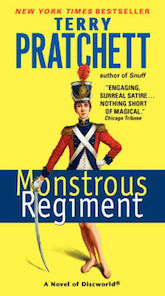 I could, of course, have filled this entire list with Pratchett books, and I was torn about which one to include. My favorite of the series is The Wee Free Men, which I’ve thrust into the hands of every 10-year-old I know. But when it comes to mash-ups, you can’t beat Monstrous Regiment: a feminist war-story with monsters. As her country fights a religious crusade, a girl dresses up as a boy to join the army and find her missing brother. Soon, she discovers that many of her fellow soldiers are also females dressed as males … although not necessarily human. As with most Discworld books, the jokes float atop a sea of deeper values—Pratchett’s outrage at the state of the world and his compassion for all those who live in it.
I could, of course, have filled this entire list with Pratchett books, and I was torn about which one to include. My favorite of the series is The Wee Free Men, which I’ve thrust into the hands of every 10-year-old I know. But when it comes to mash-ups, you can’t beat Monstrous Regiment: a feminist war-story with monsters. As her country fights a religious crusade, a girl dresses up as a boy to join the army and find her missing brother. Soon, she discovers that many of her fellow soldiers are also females dressed as males … although not necessarily human. As with most Discworld books, the jokes float atop a sea of deeper values—Pratchett’s outrage at the state of the world and his compassion for all those who live in it.
 James Alan Gardner is the author of numerous books and short stories, including the recent All Those Explosions Were Someone Else’s Fault from Tor Books. You can find him on Twitter at @jamesagard.
James Alan Gardner is the author of numerous books and short stories, including the recent All Those Explosions Were Someone Else’s Fault from Tor Books. You can find him on Twitter at @jamesagard.










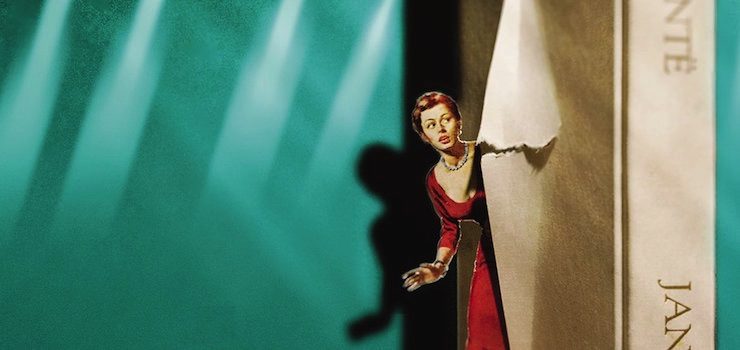
The Laundry Files by Charles Stross: Mix Spy Thrillers, Lovecraft, and Dilbert in a blender. Stir in Vampires, Elves and Superheroes. Add a dash of unicorns. Simmer gently until the Lovecraftian singularity occurs. Garnish with “Yes, Minister” and Brexit. Weep bloody tears at the end of days.
In a similar vein, there’s Glen Cook’s Garett P.I., a hardboiled noir detective in a fantasy universe. I don’t know if you’d cry, but may be.
Similar to the Laundry Files is Tim Powers’ Declare, which is more George Smiley and a little less Lovecraft than Stross.
And I’ll second the Garett books, though they do become rather less noir as the series goes on.
I suggest a View From the Imperium by Jody Lynn Nye and the Phule’s Company series. They are send ups of military sci-fi and the wonder’s of having a dedicated butler to keep ones charge out of trouble. The Thursday Next series is laugh out loud funny and, you can never go wrong with Pratchett. I have all of Tanya Huff’s vampire books and I miss the adventures of Henry and Tony they aren’t really funny but more the weird adventures of what goes on behind the scenes of this fictional tv show. I’ll have to see if I can find Radiance on audiobook because they’re is some traveling I have to do soon. I’ve never tried the Taltos books I didn’t know they could be funny. Thanks for the suggestions.
4, I wouldn’t say the Taltos books are funny, though there are moments of comedy in them, it is still serious, though a bit of caution if you branch out into Brust’s Khaavren Romances, they’re QUITE different in style. And carefully decide if you want to go with publishing order or chronological order with the Taltos books. I mean, start with Jhereg, but watch out otherwise, it can be a bit confusing.
@4 and 5. They are funny in pretty much the same manner as any of Roger Zelazny’s first person smart ass works. Lots of cynical but witty banter from the protagonist and the key figures in his orbit – not the least of which is his flying reptile psionically communicating familiar Loiosh.
6, Loiosh is a definite wit, that’s for sure. He’s the gadfly to Vlad. Smart-ass could also apply, and I think Vlad does, but the works themselves don’t go to the levels of Discworld, let alone Xanth or Sir Apropos of Nothing.
@LordVorless: given the structures of Taltos, Dragon, and Tiassa, I don’t know that the Vlad books can be read in chronological order…
8, Maybe with a knife and some glue? But yeah, there’s also a number of suggested reading orders to go by when it comes to the series. Me, I’m kinda stuck on the “Oh, there’s that book” order, so I benefit from my haphazard recall abilities.